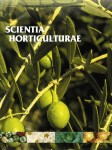Ver ítem
- xmlui.general.dspace_homeCentros Regionales y EEAsCentro Regional Buenos Aires NorteEEA San PedroArtículos científicosxmlui.ArtifactBrowser.ItemViewer.trail
- Inicio
- Centros Regionales y EEAs
- Centro Regional Buenos Aires Norte
- EEA San Pedro
- Artículos científicos
- Ver ítem
Effects of plant density in broccoli on yield and radiation use efficiency
Resumen
The effects of plant density on broccoli (Brassica oleracea L. var. italica Plenck) commercial characteristics are well determined. However, it is not completely clear how the broccoli plant respond to changes in plant shading as a result of different plant densities. The objective of this experiment was to determine the effect of plant density on intercepted photosynthetically active radiation (PAR), plant architecture, and plant growth and production.
[ver mas...]
The effects of plant density on broccoli (Brassica oleracea L. var. italica Plenck) commercial characteristics are well determined. However, it is not completely clear how the broccoli plant respond to changes in plant shading as a result of different plant densities. The objective of this experiment was to determine the effect of plant density on intercepted photosynthetically active radiation (PAR), plant architecture, and plant growth and production. “Legacy” broccoli plants were grown in pots in a greenhouse in the seasons of 2002 and 2003 at 2, 4, 6 or 8 plants m−2 (temperatures: between 10.0 and 16.1 °C, average incident PAR: 12 mol m−2 day−1). Plant density affected the intercepted and accumulated PAR. There were not effects on the length of the vegetative and reproductive periods, the total and final number of leaves, and the spear diameter and fresh weight. The magnitude and evolution of leaf area (LA) was independent of plant density up to 70 days after transplant (dat). Since then on, LA increased linearly with plant density. The highest intercepted PAR was 70–72% with 6–8 plants m−2. With the increase in plant density: the erectness of the upper leaves and stem length increased, the extinction coefficient decreased and commercial spear (inflorescence plus a portion of stem 10 cm long) weight decreased (but it was due to the stem portion of the spear and not to the edible portion). On an area basis, the decrease in commercial spear weight with plant density was more than compensated by the higher number of plants. The radiation use efficiency (RUE) increased proportionally with the leaf area index (LAI) up to a LAI of about 3, and then stabilized. The only effect of plant density on dry weight partitioning was to decrease the dry weight allocated to the stem portion of the spear. As plant density increased, and consequently the degree of shading increased, the net assimilation rate (NAR) decreased and the leaf area ratio (LAR) increased. This compensatory change between NAR and LAR, kept the relative growth rate (RGR) for individual plants almost constant.
[Cerrar]

Fuente
Scientia Horticulturae 110 (2) : 135-143. (October 2006)
Fecha
2006
Editorial
Elsevier
ISSN
0304-4238
Formato
pdf
Tipo de documento
artículo
Palabras Claves
Derechos de acceso
Restringido
 Excepto donde se diga explicitamente, este item se publica bajo la siguiente descripción: Creative Commons Attribution-NonCommercial-ShareAlike 2.5 Unported (CC BY-NC-SA 2.5)
Excepto donde se diga explicitamente, este item se publica bajo la siguiente descripción: Creative Commons Attribution-NonCommercial-ShareAlike 2.5 Unported (CC BY-NC-SA 2.5)

